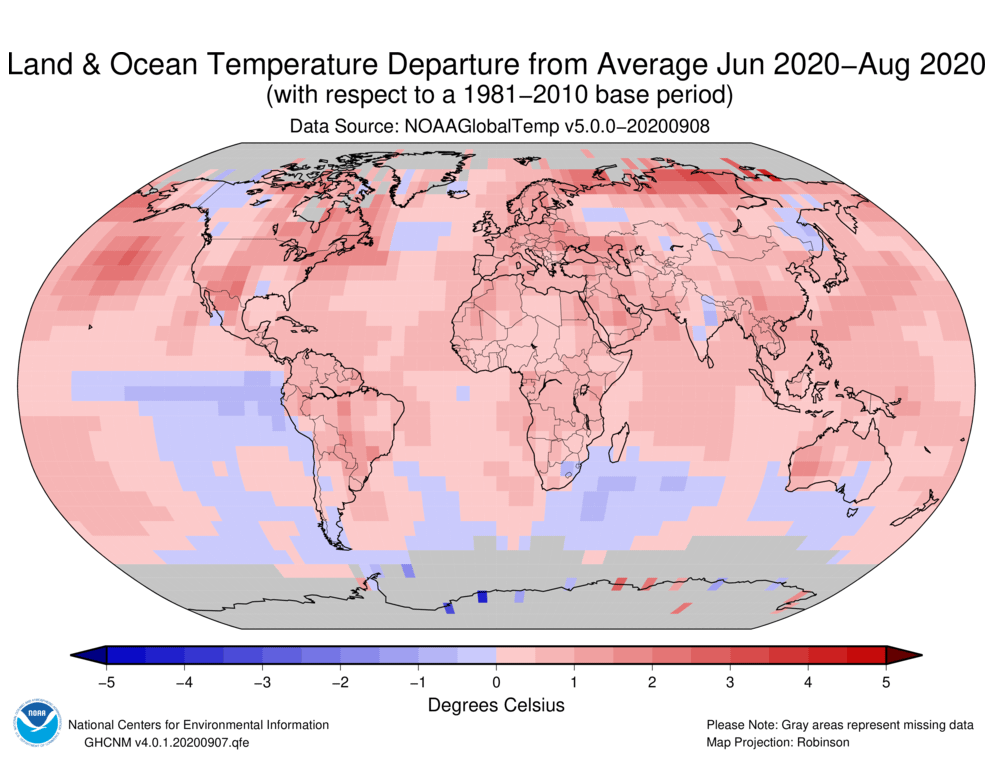 This post first appeared on the NOAA website
This post first appeared on the NOAA website
The August 2020 globally averaged temperature departure from average over land and ocean surfaces was the second-highest for the month of August in the 141-year NOAA global temperature dataset record, which dates back to 1880.
This monthly summary, developed by scientists at NOAA National Centers for Environmental Information, is part of the suite of climate services NOAA provides to government, business, academia, and the public to support informed decision-making.
August 2020 Temperature
 The August 2020 global land and ocean surface temperature was 1.69°F (0.94°C) above the 20th-century average of 60.1°F (15.6°C). This was the second-highest for August in the 141-year record. Only August 2016 had a higher temperature departure (+1.76°F / +0.98°C).
The August 2020 global land and ocean surface temperature was 1.69°F (0.94°C) above the 20th-century average of 60.1°F (15.6°C). This was the second-highest for August in the 141-year record. Only August 2016 had a higher temperature departure (+1.76°F / +0.98°C).
- August 2020 marked the 44th consecutive August and the 428th consecutive month with temperatures, at least nominally, above the 20th-century average.
- The 10 warmest Augusts have all occurred since 1998. The five warmest Augusts have occurred since 2015.
- The Northern Hemisphere had its warmest August on record with a combined land and ocean surface temperature departure from average of 2.14°F (1.19°C). This value surpassed the previous record set in 2016 by 0.05°F (0.03°C). Meanwhile, the Southern Hemisphere’s land and ocean surface temperature departure from average for August 2020 was the sixth highest on record at 1.21°F (0.67°C) above average.
- North America had its warmest August on record, with a temperature departure from average of +2.74°F (+1.52°C). This exceeded the previous record set in 2011 by 0.23°F (0.13°C). Europe and the Caribbean region had their third-warmest August, while South America and Oceania had their fourth warmest on record.
- The most notable temperature departures from average during August 2020 were present across parts of the western contiguous U.S., Europe, north-central Russia, southeastern China, Western Australia, the North Pacific Ocean, the Bering Sea, and parts of the eastern Antarctic, where temperatures were at least 2.7°F (1.5°C) above average.
 Sea Ice
Sea Ice

The August average Arctic sea ice extent was the third smallest on record at 820,000 square miles (29.4 percent) below the 1981–2010 average, according to analysis by the National Snow and Ice Data Center (NSIDC) using data from NOAA and NASA. This was behind the two smallest extents which occurred in 2012 and 2019.
Antarctic sea ice extent during August 2020 was close to normal at 6.83 million square miles. This was the highest August Antarctic sea ice extent since 2016.
June-August 2020 Temperature

- The Northern Hemisphere had its warmest June-August period on record at 2.11°F (1.17°C) above average, surpassing the now second-warmest such period set in 2016 and again in 2019. The five warmest June-August periods for the Northern Hemisphere have occurred since 2015.
- During the three-month period of June-August 2020, the Caribbean region had its second-warmest such period on record, while North America and South America had their third-warmest June-August since regional records began in 1910.
- Temperature departures from average above 3.6°F (2.0°C) were observed across parts of northern Russia, southwestern and northeastern contiguous U.S., eastern Canada, and the North Pacific Ocean. The most notable cool temperatures were present across parts of western Antarctica.
- Record warm temperatures during the season were observed across parts of southern and northern Asia, Australia, North and South America, as well as the Caribbean Sea, northern Indian Ocean, and the western Pacific Ocean.

 January-August 2020 Temperature
January-August 2020 Temperature
The year-to-date global land and ocean surface temperature was also the second-highest in the 141-year record at 1.85°F (1.03°C) above the 20th-century average of 57.3°F (14.0°C). This value is only 0.09°F (0.05°C) less than the record set in 2016.
- The Northern Hemisphere January-August land and ocean surface temperature tied with 2016 as the warmest such period since global records began in 1880. The Southern Hemisphere had its third-warmest such period (tied with 2017) on record, behind 2016 and 2019.
- Europe, Asia, and the Caribbean region had their warmest January-August period on record. South America had a January-August temperature that ranked as the second-highest on record.
- Warmer-than-average temperatures engulfed much of the global land and ocean surface temperatures during January-August, with the most notable warm temperature departures across much of northern Asia, where temperatures were at least 5.4°F (3.0°C) above average. Meanwhile, cooler-than-average conditions were limited to Alaska, western Canada, northern India, and across the southern oceans.
- Record warm January-August temperatures were present across much of northern Asia and across parts of southeastern China, Europe, northern Africa, northern South America, Central America as well as the Atlantic, Indian and Pacific oceans.
- According to a statistical analysis done by NCEI scientists, the year 2020 is very likely to rank among the five warmest years on record.
For a more complete summary of climate conditions and events, see the August 2020 Global Climate Report.
 Sea Ice
Sea Ice
 January-August 2020 Temperature
January-August 2020 Temperature